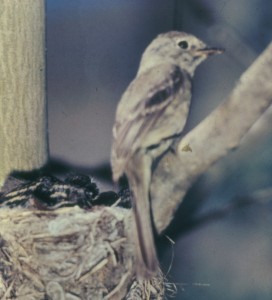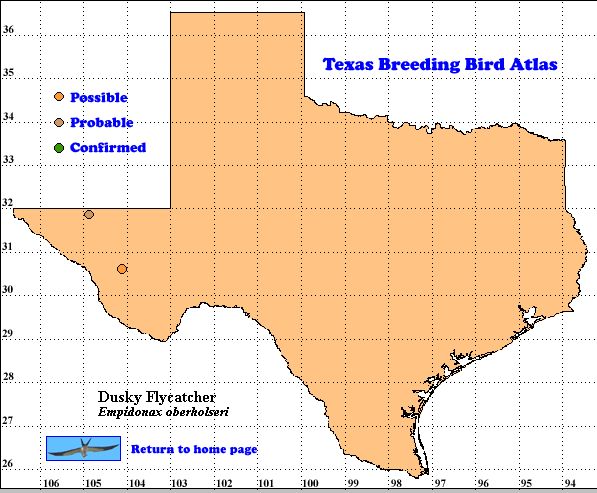The Dusky Flycatcher is, as its name indicates, a visually nondescript Empidonax. It breeds though the higher mountains of western United States and Canada.
Historically this species and the Cray Flycatcher (E. wrighti) were confused. This was clarified after Allan Phillips pointed out that the type specimen of Dusky Flycatcher was actually a Gray Flycatcher and that the two species could be distinguished in the field by differences in the tail movements of perched birds. Differences in vocalizations are the most reliable method of sorting out this confusing genus (Sterling 1999).
DISTRIBUTION. During the 1987-1992 field work for the TBBA project researchers found probable breeding evidence for Dusky Flycatcher in the Davis and Guadalupe mountains of the Trans-Pecos region, areas where they have been reported in recent years as rare summer residents. After completion of the TBBA field work, breeding was confirmed in 2000 ( Lockwood and Freeman 2004).
Outside Texas the species breeds from northwest British Columbia south through the Canadian Rockies, Cascade, Sierra Nevada, California Coast ranges and Rocky Mountains to northern Baja California (Mexico), Arizona and New Mexico.
Dusky Flycatcher winters from southeast Arizona and the Rio Grande River in southern Trans-Pecos Texas through the central highlands of Mexico to the Isthmus of Tehuantepec. (Sedgwick 1993, Howell and Webb 1995, Lockwood and Freeman 2004).
SEASONAL OCCURRENCE. Dusky Flycatchers are common migrants through the western Trans-Pecos region from April 13 to June 6 and August 5 to October 4. Breeding probably occurs from late May to early August (Oberholser 1974, Lockwood and Freeman 2004).
BREEDING HABITAT. Dusky Flycatchers probably breed most frequently in Texas in open deciduous woodland in canyons at about 2000 m (6600 ft) elevation (Oberholser 1974).
The nest is placed in an upright crotch of a willow or alder tree, or a low bush, 1-2 m (4-7 ft) above the ground. It is a compact, well built cup made of forb stems, grasses, vegetable fiber and plant down, lined with fine bark, plant down and animal hair and often bound together with spider silk. The outside diameter is 7 cm (2.8 in), height 9 cm (3.5 in), inside diameter 4.5 cm (1.8 in ), cup depth 5 cm (2 in). The Gray Flycatcher builds a bulky, less tidy nest (Harrison 1979).
The female usually lays 3-4 dull white, rarely spotted eggs, generally indistinguishable from eggs of Gray Flycatcher. The female incubates the eggs for 12-15 days; the male sometimes feeds her on the nest. The young birds leave the nest at about 18 days after hatching. The rate of parasitism by Brown-headed Cowbird (Molothrus ater) appears relatively low (Harrison 1979, Sedgwick 1993).
STATUS. The species is not well sampled in Texas by the North American Breeding Bird Survey (BBS), so no meaningful population trend data are available for Dusky Flycatcher. Across the range of the species in North America data from 411 BBS routes produce a 95% confidence interval (There is a 95% chance that the actual population trend will be between these two numbers) of -2.4 to 0.2% population change per year for the period 1966-2004 (Sauer et al. 2005). This trend estimate suggests Dusky Flycatcher should continue as a migrant in extreme west Texas into the future and perhaps continue to breed in the Trans-Pecos mountains.
Text by Robert C. Tweit (2005)
Literature cited.
Harrison, H. H. 1979. A field guide to western birds’ nests. Houghton Mifflin, Boston, MA.
Howell, S. N. G. and S. Webb. 1995. A guide to the birds of Mexico and northern Central America. Oxford University Press, New York.
Lockwood, M. W. and B. Freeman. 2004. The TOS handbook of Texas birds. Texas A&M University Press, College Station.
Oberholser, H. C. 1974. The bird life of Texas. University of Texas Press, Austin.
Sauer, J. R., J. E. Hines, and J. Fallon. 2005. The North American Breeding Bird Survey, results and analysis 1966-2004. Version 2005.1. USGS Patuxent Wildlife Research Center, Laurel MD (Web site, http://www.mbr-pwrc.usgs.gov/bbs).
Sedgwick, J. A.1993. Dusky Flycatcher (Empidonax oberholseri). In The birds of North America, No. 78 (A. Poole and F. Gill, eds.). The Birds of North America, Inc., Philadelphia, PA.

